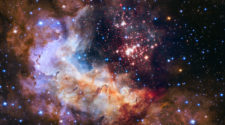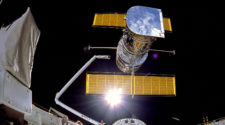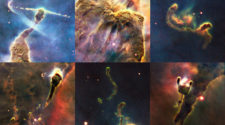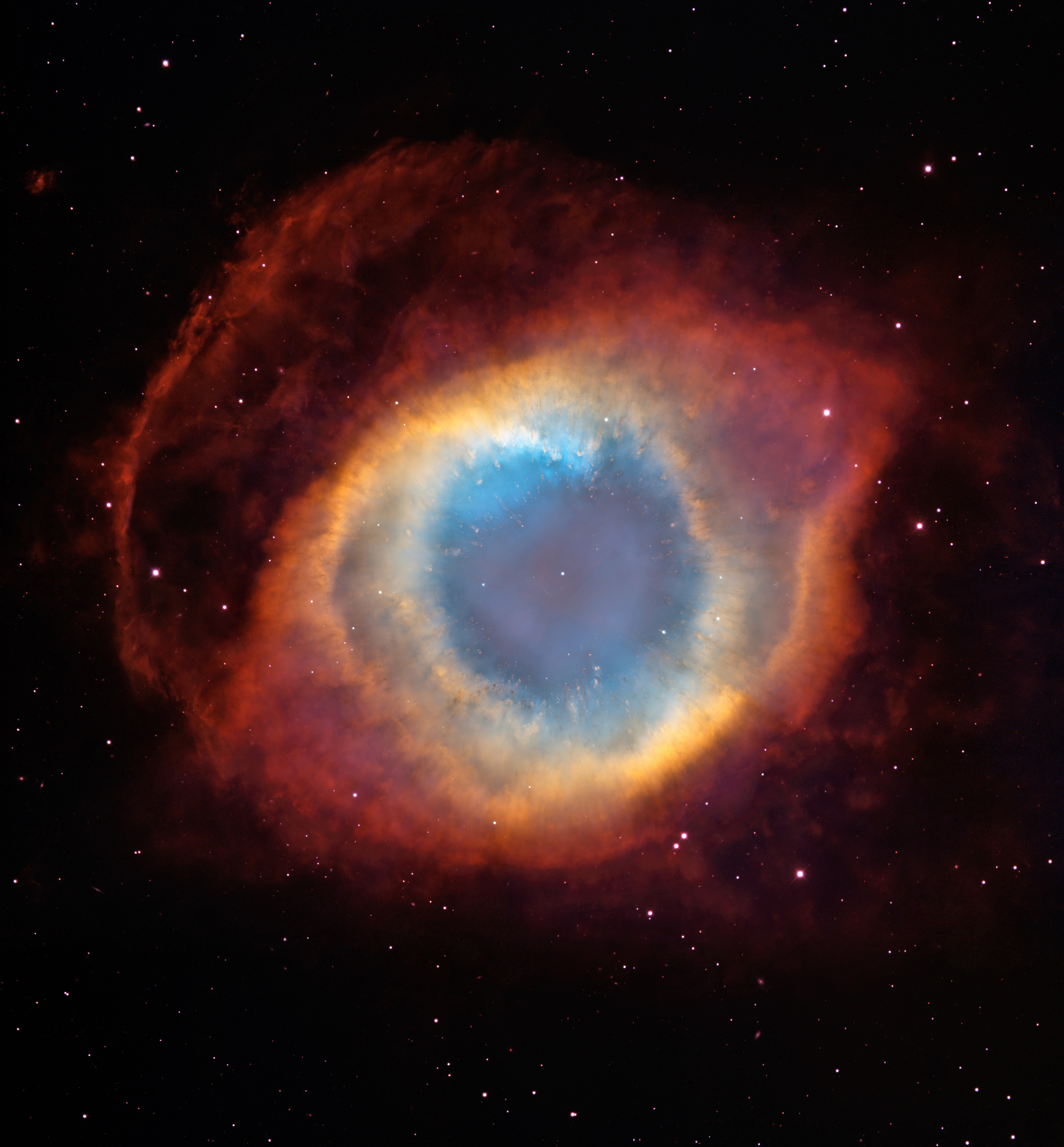
91. New view of the Helix Nebula
This composite image is a view of the colorful Helix Nebula taken with the Advanced Camera for Surveys aboard the Hubble Space Telescope and the Mosaic II Camera on the 4-meter telescope at Cerro Tololo Inter-American Observatory in Chile. The object is so large that both telescopes were needed to capture a complete view. The Helix is a planetary nebula, the glowing gaseous envelope expelled by a dying, sun-like star. The Helix resembles a simple doughnut as seen from Earth. But looks can be deceiving. New evidence suggests that the Helix consists of two gaseous disks nearly perpendicular to each other.
Hubble’s top discoveries “is a very personal list:
“1) The accelerating universe, kind of a no-brainer there, we think most people would agree with that. The Nobel committee thought so, too.
“2) Accurate determination of the Hubble constant, the current rate at which the universe is expanding. Prior to Hubble the telescope, Hubble the number wasn’t known to better than a factor of two. It’s now at ~10% accuracy.
“3) Discovery that every large galaxy has a supermassive black hole at its center. This one might not make everyone’s list, but it’s what we work on!”
Dr. Bradley M. Peterson and Dr. Gisella De Rosa
(Peterson) Professor and Chair of Astronomy, Ohio State University, Columbus, Ohio
(De Rosa) Visiting Astronomer, Space Telescope Science Institute, Baltimore, Maryland
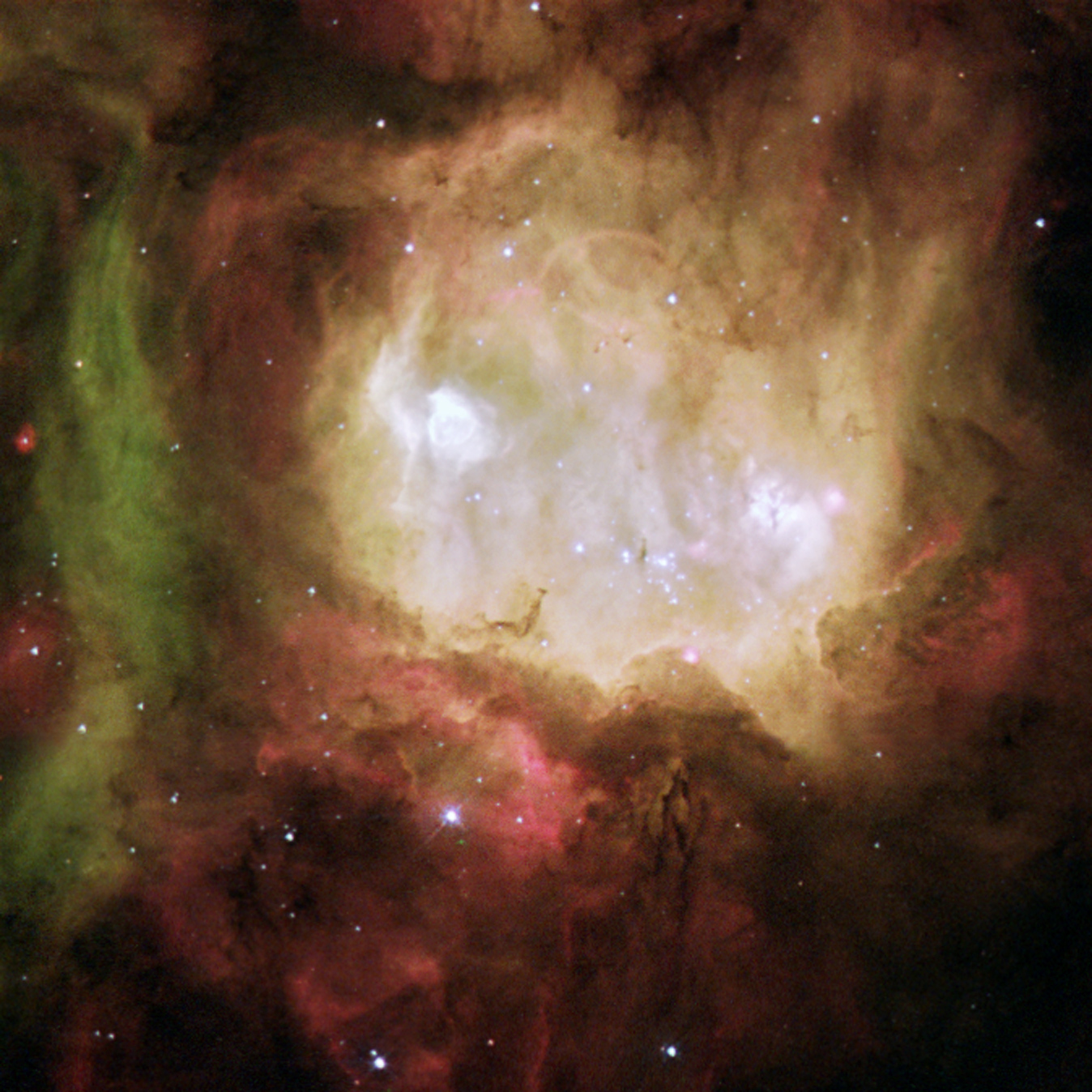
92. Ghost Head Nebula
The Ghost Head Nebula is one of a chain of star-forming regions lying south of the 30 Doradus nebula in the Large Magellanic Cloud. Two bright regions (the ‘eyes of the ghost’), named A1 (left) and A2 (right), are very hot, glowing ‘blobs’ of hydrogen and oxygen.
The bubble in A1 is produced by the hot, intense radiation and powerful stellar wind from a single massive star. A2 has a more complex appearance due to the presence of more dust, and it contains several hidden, massive stars.
The massive stars in A1 and A2 must have formed within the last 10 000 years since their natal gas shrouds are not yet disrupted by the powerful radiation of the newly born stars.
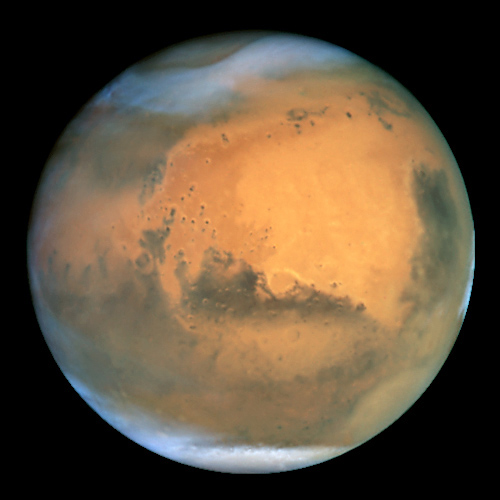
93. Best Earth-based view of Mars ever
Frosty white water ice clouds and swirling orange dust storms above a vivid rusty landscape reveal Mars as a dynamic planet in this sharpest view ever obtained by an Earth-based telescope.
The Earth-orbiting Hubble telescope snapped this picture on June 26, when Mars was approximately 43 million miles (68 million km) from Earth – its closest approach to our planet since 1988. Hubble can see details as small as 10 miles (16 km) across.
Especially striking is the large amount of seasonal dust storm activity seen in this image. One large storm system is churning high above the northern polar cap [top of image], and a smaller dust storm cloud can be seen nearby. Another large duststorm is spilling out of the giant Hellas impact basin in the Southern Hemisphere [lower right].
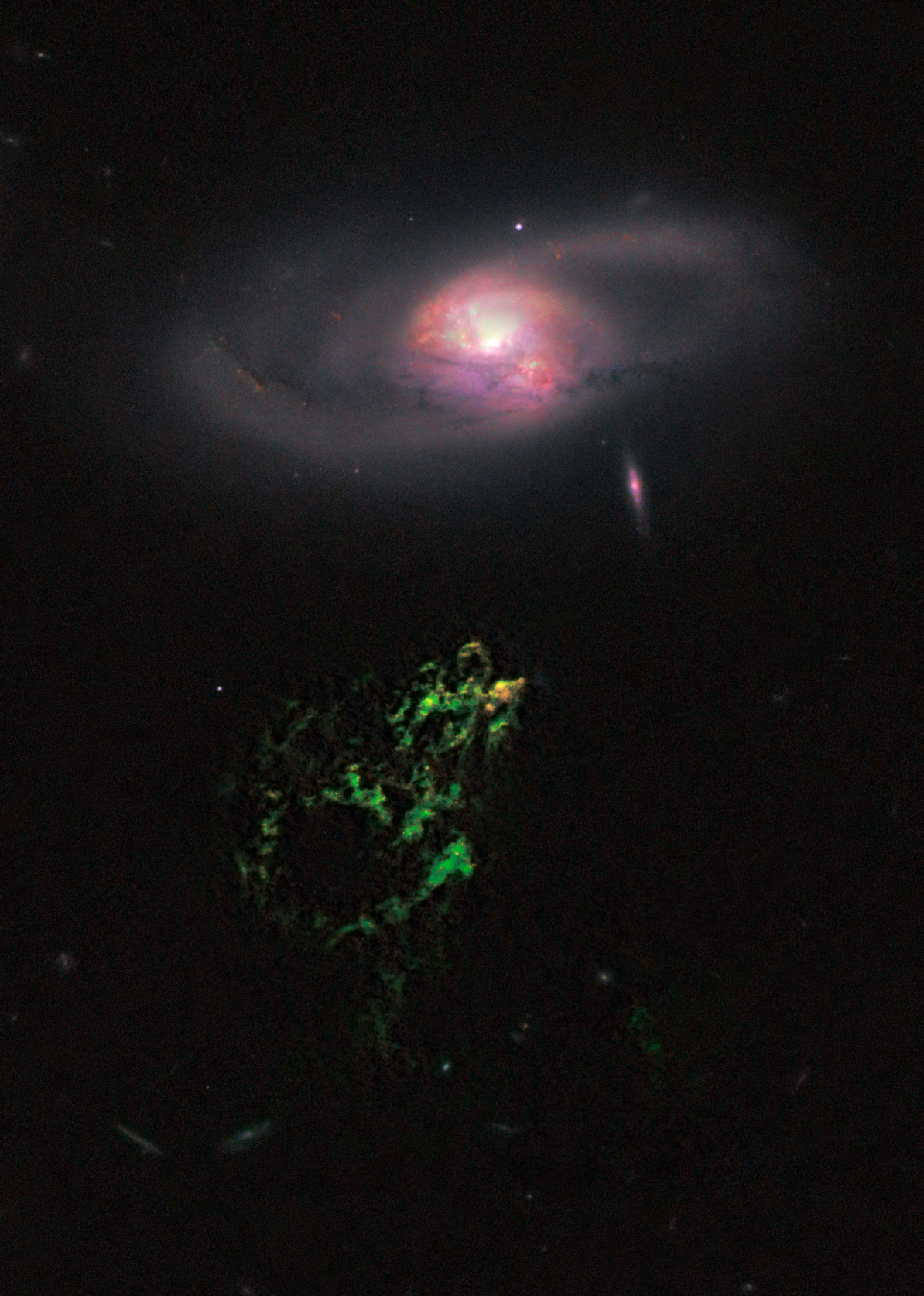
94. A space oddity
In this image by the NASA/ESA Hubble Space Telescope, an unusual, ghostly green blob of gas appears to float near a normal-looking spiral galaxy.
The bizarre object, dubbed Hanny’s Voorwerp (Hanny’s Object in Dutch), is the only visible part of a streamer of gas stretching 300 000 light-years around the galaxy, called IC 2497. The greenish Voorwerp is visible because a searchlight beam of light from the galaxy’s core has illuminated it. This beam came from a quasar, a bright, energetic object that is powered by a black hole. The quasar may have turned off in the last 200 000 years.
This Hubble view uncovers a pocket of star clusters, the yellowish-orange area at the tip of Hanny’s Voorwerp. The star clusters are confined to an area that is a few thousand light-years wide. The youngest stars are a couple of million years old. The Voorwerp is the size of the Milky Way, and its bright green colour is from glowing oxygen.
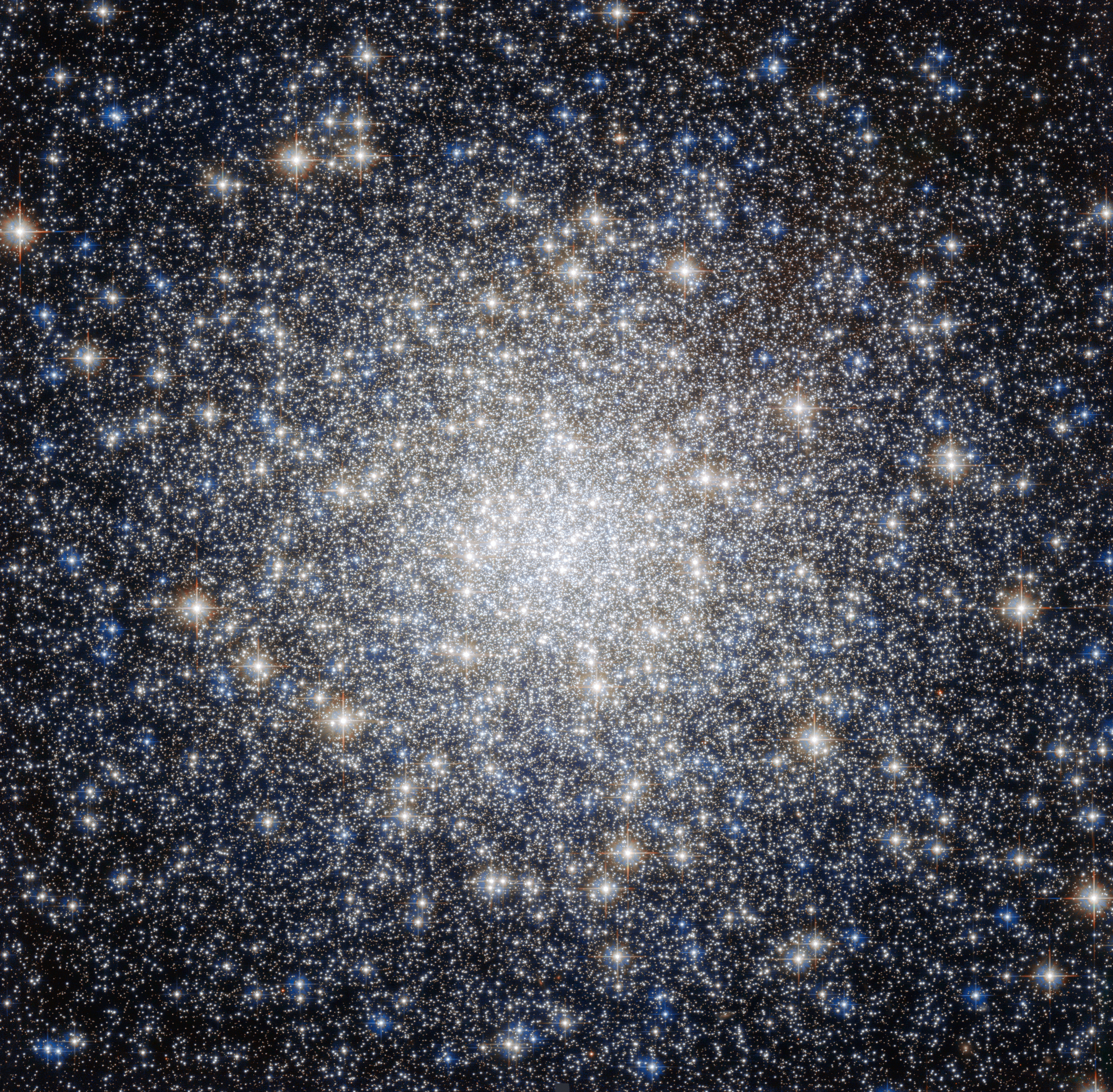
95. All that glitters
This striking Hubble Space Telescope image shows a glittering bauble named Messier 92. Located in the northern constellation of Hercules, this globular cluster — a ball of stars that orbits a galactic core like a satellite — was first discovered by astronomer Johann Elert Bode in 1777.
Messier 92 is one of the brightest globular clusters in the Milky Way, and is visible to the naked eye under good observing conditions. It is very tightly packed with stars, containing some 330 000 stars in total. As is characteristic of globular clusters, the predominant elements within Messier 92 are hydrogen and helium, with only traces of others. It is actually what is known as an Oosterhoff type II (OoII) globular cluster, meaning that it belongs to a group of metal-poor clusters — to astronomers, metals are all elements heavier than hydrogen and helium.
By exploring the composition of globulars like Messier 92, astronomers can figure out how old these clusters are. As well as being bright, Messier 92 is also old, being one of the oldest star clusters in the Milky Way, with an age almost the same as the age of the Universe.
“It is hard to say what Hubble’s lasting scientific legacy will be, as I would imagine there are fundamental discoveries across the entire range of sub-fields within astronomy and physics.
“With regards to Hubble’s legacy amongst society, the story of Hubble is a human one which can touch all of us. Hubble overcame adversity early on, from problems with the mirror optics to gyroscope and instrument failures.
“Despite all of these challenges, Hubble has proceeded to revolutionize our understanding of the cosmos. NASA believes that Hubble can get to 2020 and beyond, a lifetime that was likely inconceivable at launch.
“To me, Hubble’s story tells us that with perseverance, we can far exceed our own expectations.”
Dr. Katherine E. Whitaker
NASA Postdoctoral Program Fellow
Goddard Space Flight Center
Greenbelt, Maryland
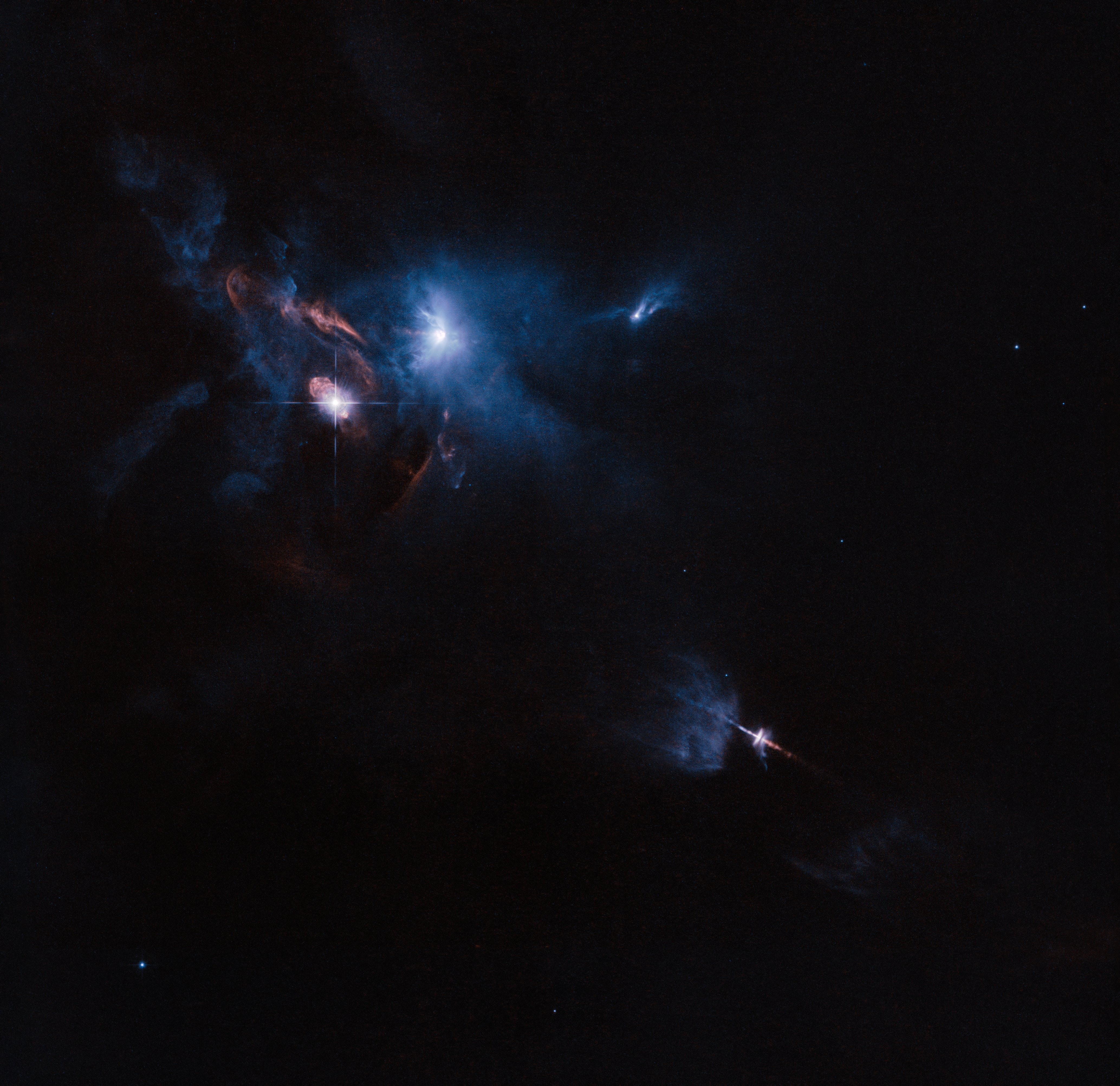
96. Jets, bubbles and bursts of light in Taurus
The Hubble Space Telescope has snapped a striking view of a multiple star system called XZ Tauri, its neighbour HL Tauri and several nearby young stellar objects. XZ Tauri is blowing a hot bubble of gas into the surrounding space, which is filled with bright and beautiful clumps that are emitting strong winds and jets. These objects illuminate the region, creating a truly dramatic scene.
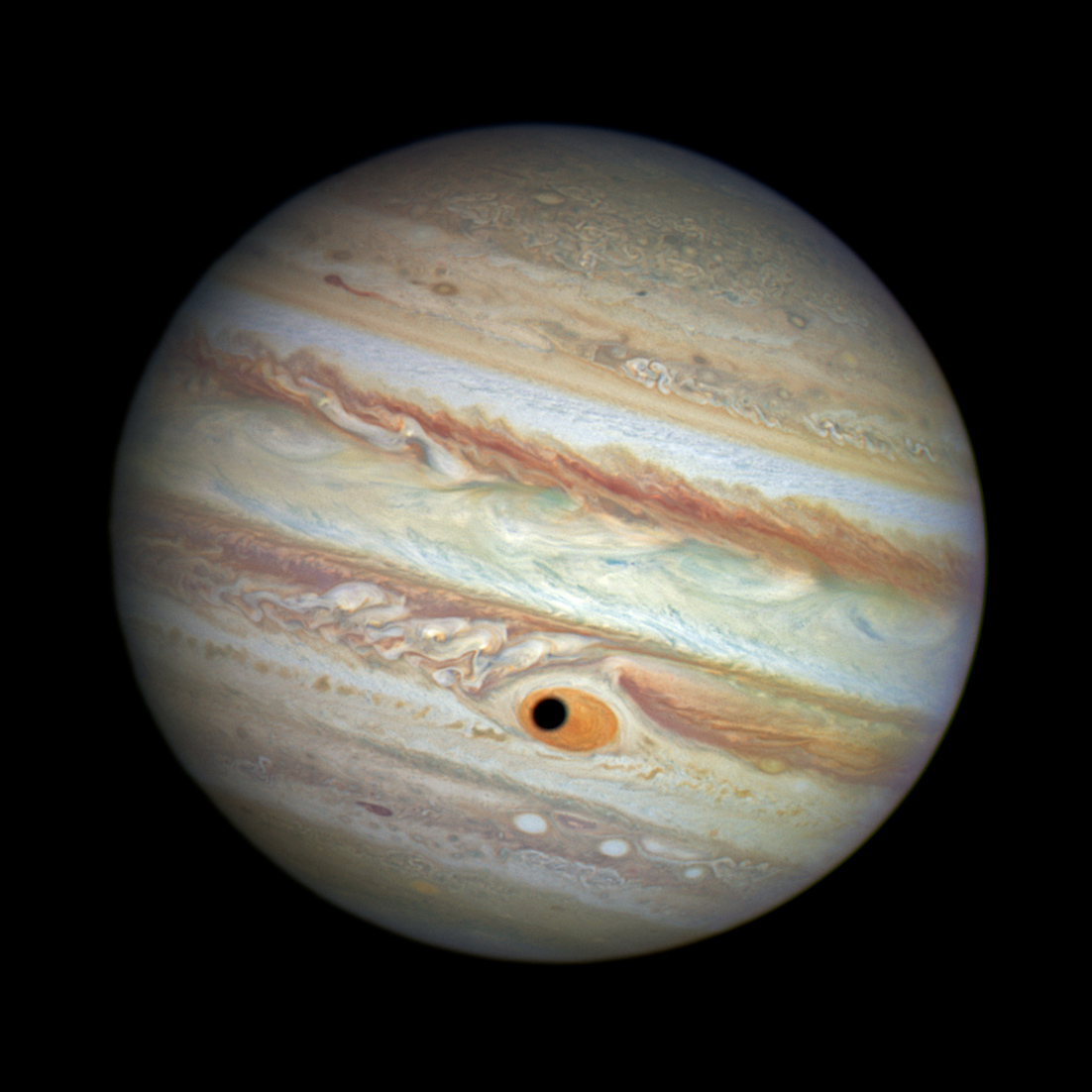
97. Jupiter’s Red Spot and Ganymede’s shadow
This Hubble image shows a gorgeous close-up view of the planet Jupiter.
Astronomers were using Hubble to monitor changes in Jupiter’s immense Great Red Spot (GRS) storm. During the exposures, on 21 April 2014, the shadow of the Jovian moon Ganymede swept across the center of the GRS. Giving the giant planet the uncanny appearance of having a pupil in the center of a 16 000 kilometre wide eye.
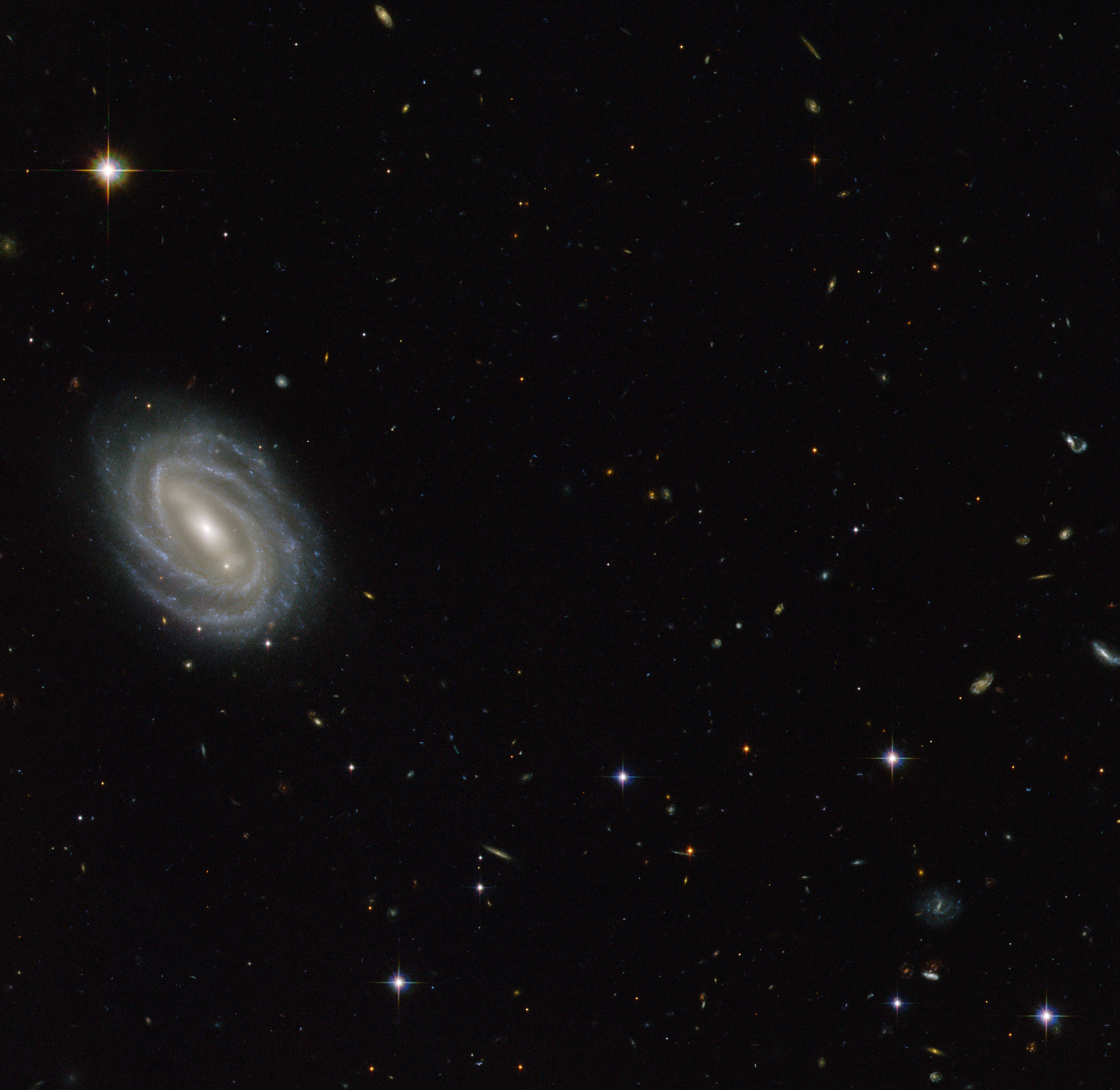
98. Spiral in Serpens
This new NASA/ESA Hubble Space Telescope image shows a beautiful spiral galaxy known as PGC 54493, located in the constellation of Serpens (The Serpent). This galaxy is part of a galaxy cluster that has been studied by astronomers exploring an intriguing phenomenon known as weak gravitational lensing.
This effect, caused by the uneven distribution of matter (including dark matter) throughout the Universe, has been explored via surveys such as the Hubble Medium Deep Survey. Dark matter is one of the great mysteries in cosmology. It behaves very differently from ordinary matter as it does not emit or absorb light or other forms of electromagnetic energy — hence the term “dark”.
Even though we cannot observe dark matter directly, we know it exists. One prominent piece of evidence for the existence of this mysterious matter is known as the “galaxy rotation problem”. Galaxies rotate at such speeds and in such a way that ordinary matter alone — the stuff we see — would not be able to hold them together. The amount of mass that is “missing” visibly is dark matter, which is thought to make up some 27% of the total contents of the Universe, with dark energy and normal matter making up the rest. PGC 55493 has been studied in connection with an effect known as cosmic shearing. This is a weak gravitational lensing effect that creates tiny distortions in images of distant galaxies.
“Hubble brought the Universe into our backyard. Or rather, it expanded our backyards to enclose the Universe itself. It did that with images so intellectually, visually, and even spiritually fulfilling that most don’t even need captions.”
Neil deGrasse Tyson
Director of Hayden Planetarium
American Museum of Natural History
New York, New York
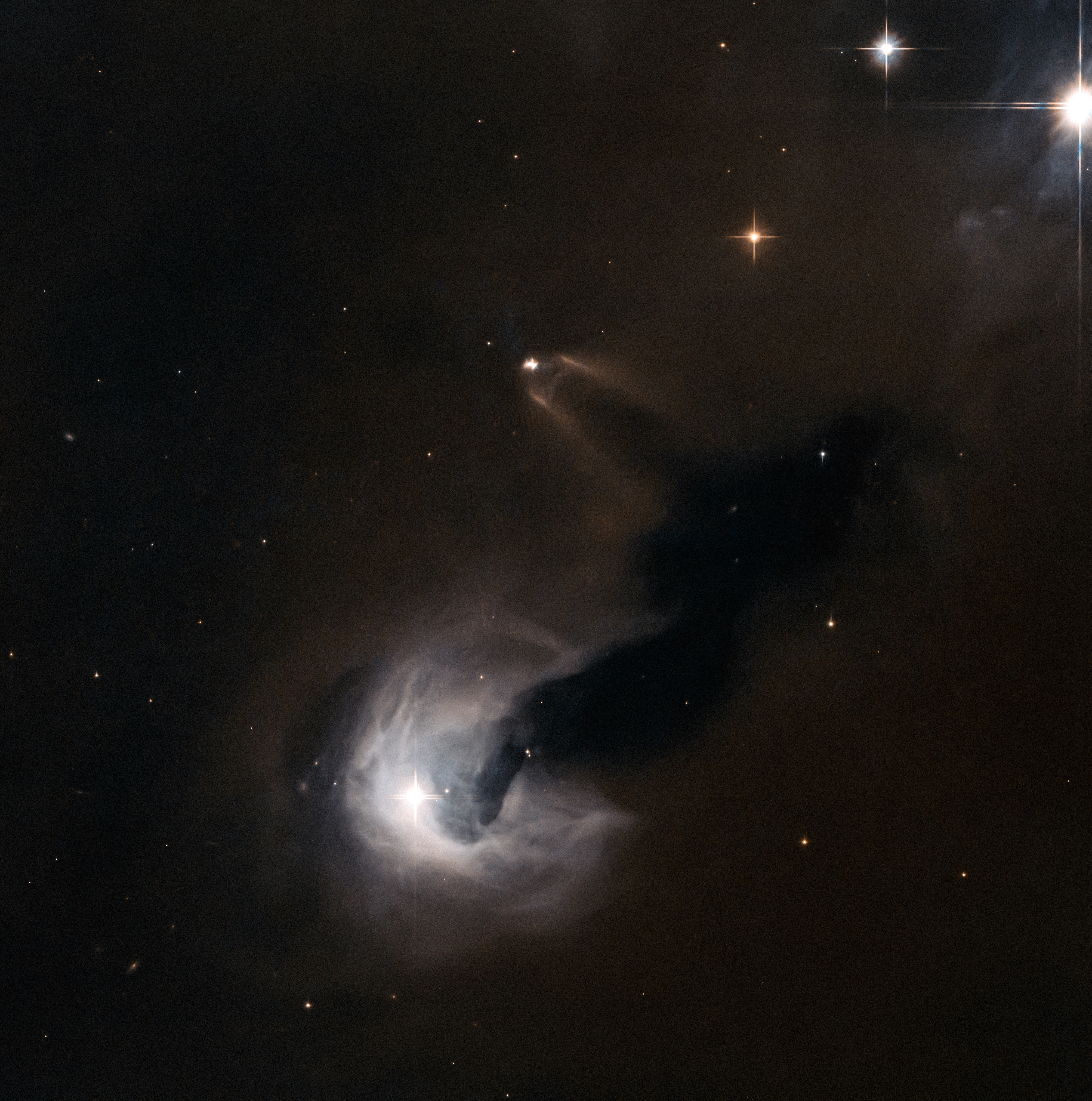
99. Light and dark
Surrounded by bright stars, towards the upper middle of the frame we see a small young stellar object (YSO) known as SSTC2D J033038.2+303212. Located in the constellation of Perseus, this star is in the early stages of its life and is still forming into a fully grown star. In this view it appears to have a murky chimney of material emanating outwards and downwards, framed by bright bursts of gas flowing from the star itself. This fledgling star is actually surrounded by a bright disc of material swirling around it as it forms — a disc that we see edge-on from our perspective.
However, this small bright speck is dwarfed by its cosmic neighbour towards the bottom of the frame, a clump of bright, wispy gas swirling around as it appears to spew dark material out into space. The bright cloud is a reflection nebula known as [B77] 63, a cloud of interstellar gas that is reflecting light from the stars embedded within it.
These stars are lighting up the surrounding gas and sculpting it into the wispy shape seen in this image. However, the most dramatic part of the image seems to be a dark stream of smoke piling outwards from [B77] 63 and its stars — a dark nebula called Dobashi 4173. Dark nebulae are incredibly dense clouds of pitch-dark material that obscure the patches of sky behind them.
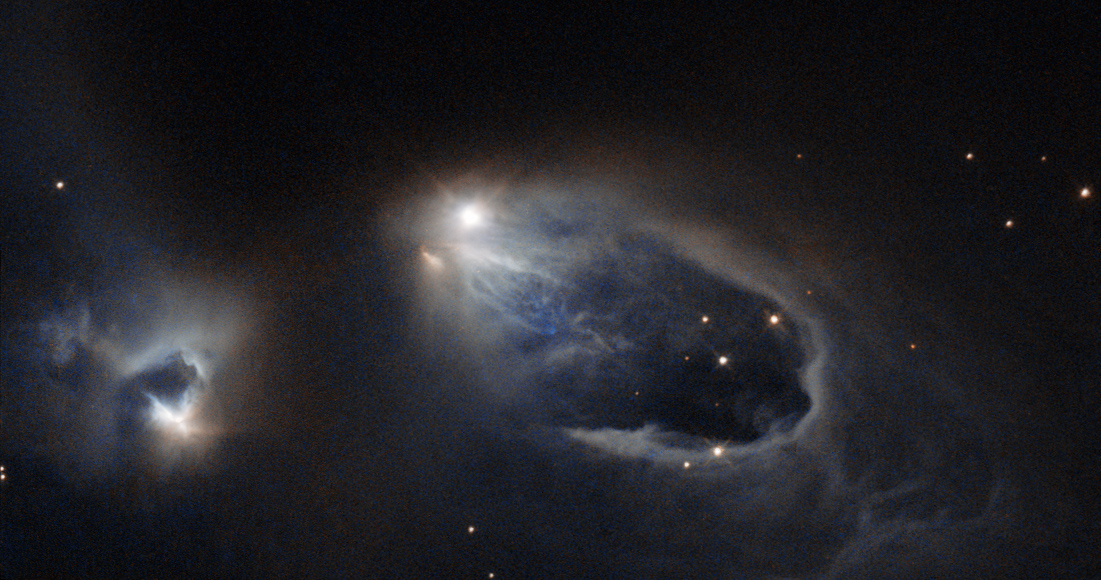
100. Stellar sneezing fit
Look at the bright star in the middle of this image. Achoo! It has just sneezed. This sight will only last for a few thousand years — a blink of an eye in the young star’s life.
If you could carry on watching for a few years you would realise it’s not just one sneeze, but a sneezing fit. This young star is firing off salvos of super-hot, super-fast gas before it finally exhausts itself. These bursts of gas have shaped the turbulent surroundings, creating structures known as Herbig-Haro objects.
These objects are formed from the star’s energetic “sneezes”. These salvos can contain as much mass as our home planet, and cannon into nearby clouds of gas at hundreds of kilometres per second. Shock waves form, such as the U-shape below this star. Unlike most other astronomical phenomena, as the waves crash outwards, they can be seen moving across human timescales. Soon, this star will stop sneezing, and grow up to be a star like the Sun.
Visit Hubble here on Earth
Artifacts from the Hubble Space Telescope and high fidelity models of the telescope are available for public viewing.
At the Kennedy Space Center Visitors Complex in Florida a high fidelity model of Hubble is displayed alongside Space Shuttle Atlantis.
Among the items on display at National Air and Space Museum on the National Mall in Washington, D.C., are:
- Hubble Space Telescope Structural Dynamic Test Vehicle (SDTV), essentially a copy of the spacecraft used for testing everything from handling procedures to ensuring wiring harnesses bound for the flight vehicle fit properly.
- Primary Mirror (flight spare), correctly polished
- IMAX camera used by shuttle crew.
- HST-PCU Trainer, used by astronauts on the ground to practice the difficult task of replacing the Power Control Unit during servicing mission
- The original Wide Field Planetary Camera 1 is also in the NASM museum collection.

